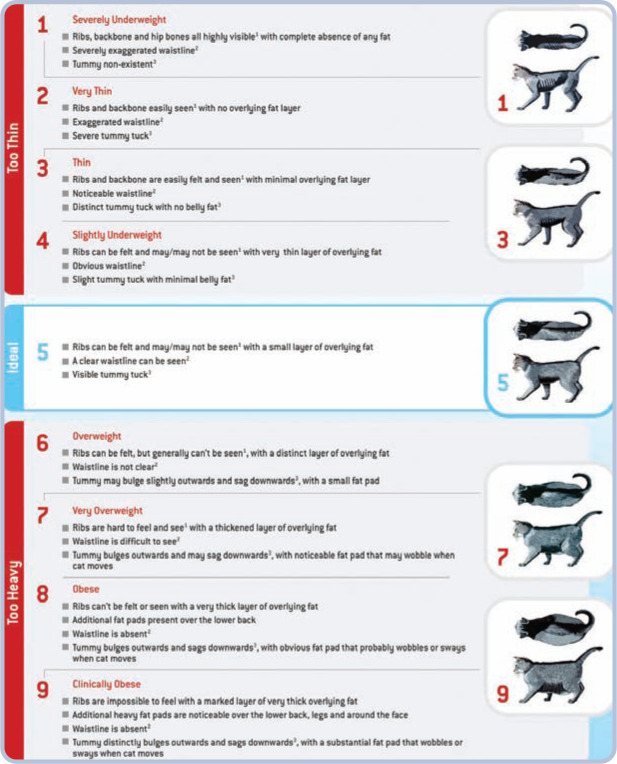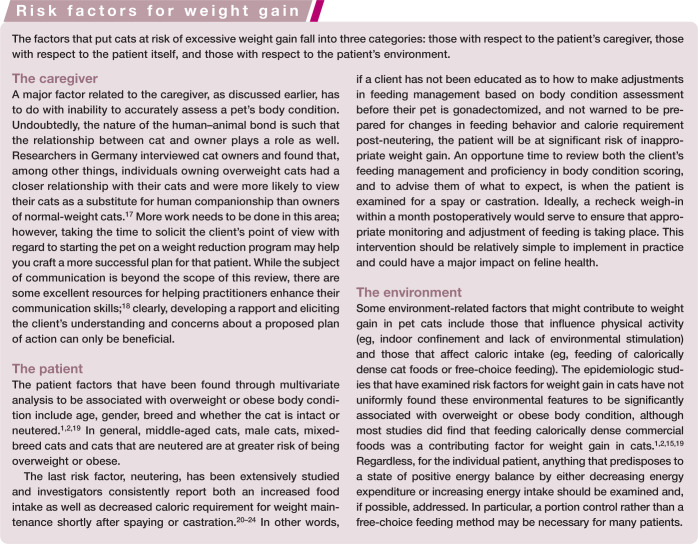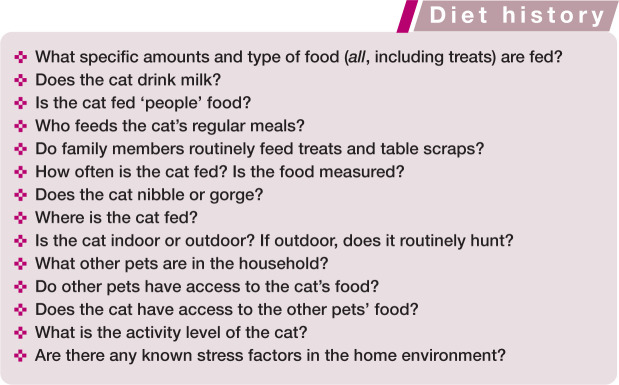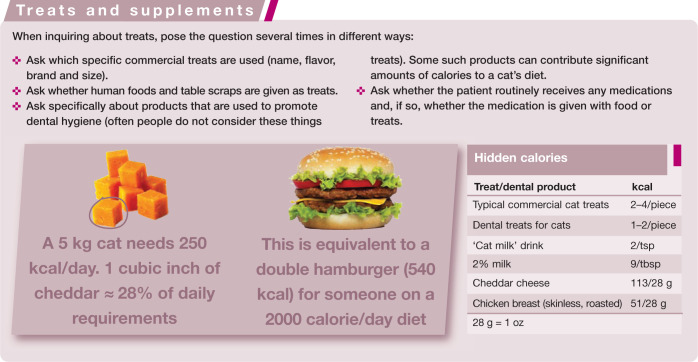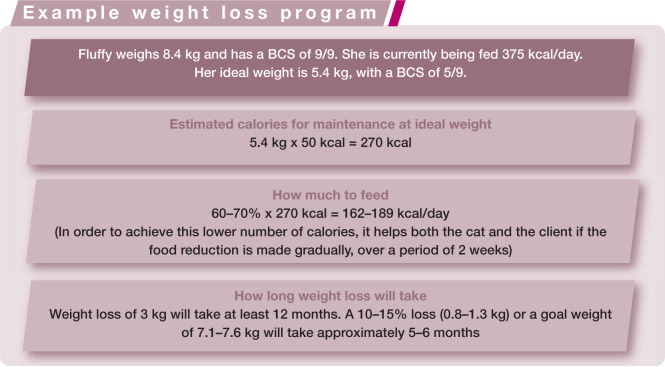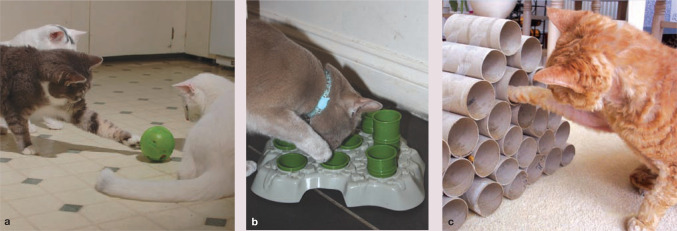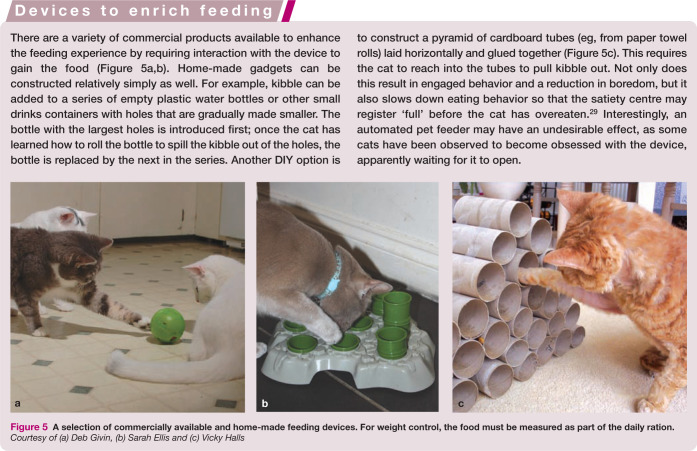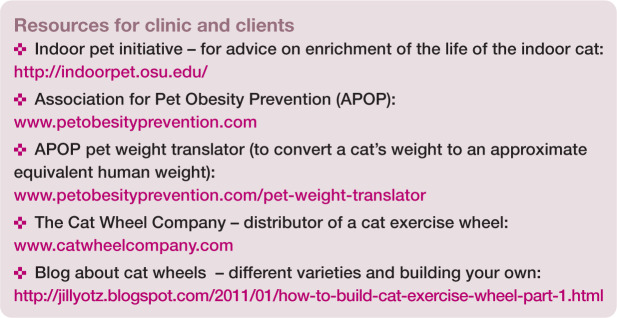Abstract
Practical relevance: Obesity is the most common unhealthy nutritional condition that is recognized in cats. Documented associated health risks include diabetes mellitus, lameness, non-allergic skin disease, feline lower urinary tract disease and idiopathic hepatic lipidosis.
Clinical challenges: Simply recommending a diet designed for weight loss fails, in most cases, to result in successful weight loss in the obese or overweight cat. A more in-depth approach that centers on communication and commitment, alongside a program of feeding a predetermined amount of a specific diet plus exercise and enrichment of the cat’s life, offers a chance for a healthy result.
Patient group: It has been reported in some developed countries that as much as 40–50% of the feline population may be overweight or obese, with middle-aged cats, male cats, mixed-breed cats and neutered cats being at greatest risk.
Audience: This review of what is currently known about the health risks, predisposing factors and treatment of excessive weight gain in cats is aimed at all veterinary health professionals.
Evidence base: The information reported in the review is drawn from the current scientific literature as well as from the clinical experience of the authors.
Consumption of kcal > energy expenditure = weight gain
By far the most common nutritional condition that is recognized in pet cats is the problem of excessive weight gain. There have not been any recent large scale investigations of the prevalence of this condition; however, an investigation from the mid-1990s found that nearly 29% of 8159 cats over 1 year old and living throughout the United States were classified as overweight, with a body condition score (BCS) of 4/5, and another 6.4% were judged grossly obese (BCS = 5/5). 1 There is no reason to think that the situation has improved in the past 15 years, nor is this problem limited to the US, as a more recent investigation in France attests. 2 The investigators in that study evaluated 385 healthy cats seen at a veterinary school vaccination clinic and found that 27% had a BCS of 4/5 or 5/5. These figures are concerning, but they do not reveal the entire picture. When the US data was analyzed to look at the proportion of cats with a BCS of ≥4/5 by age, the percentage of overweight/obese cats aged 5–12 years rose to between 40 and 50%. 3
A generally agreed upon definition of obesity is a body weight 20% or more above ideal, with individuals weighing 10–20% over ideal considered overweight. 4 Weight maintenance is a matter of energy balance – weight gain will occur when a cat consumes calories in excess of its energy expenditure. Such a scenario can happen all too easily given the pampered lifestyle of many domesticated cats. For example, a 4 kg cat consuming a mere 10 kcal/day in excess of its daily energy needs (the equivalent of about 10 kibbles of a typical dry cat food) will gain nearly 0.5 kg of adipose tissue (the energy content of adipose is estimated as 7920 kcal/kg) or 12% of its body weight over the course of just 1 year.
So, given that excessive weight gain can happen readily, appears to be a common phenomenon among pet cats, and, regrettably, has a negative impact on health, how do practitioners address this serious condition?
Health risks of excessive weight gain
While the hazards of obesity have not been as extensively studied in cats as in some other species, there is evidence that overweight cats are at increased risk of a number of pathologic conditions. Retrospective studies have found excessive body weight to be a risk factor for feline lower urinary tract disease and idiopathic hepatic lipidosis.5,6 In an epidemiologic study of nearly 1500 cats living in the northeastern United States, an association was found between overweight or obese BCS and diabetes mellitus, lameness and non-allergic skin disease. 7
In recent years, the focus has shifted to elucidating what role excessive adiposity plays in the pathogenesis of these conditions. Increasingly, we are recognizing that white adipose tissue (WAT) is not simply an energy depot but rather a metabolically active secretory organ. 8 Furthermore, progression from a lean to an obese state leads to alterations in the morphology and secretions of WAT that may underlie the pathogenesis of some of the conditions associated with obesity.
It has been recognized for several decades that, with weight gain, cats develop glucose intolerance and impaired insulin secretion.9,10 Those findings, coupled with the epidemiologic evidence that obese cats have a nearly four-fold greater risk of becoming diabetic compared with normal-weight cats, 7 have led investigators to take a closer look at the metabolism of WAT in lean and obese cats.
The peptides and hormones secreted by WAT are collectively known as adipokines and include leptin, adiponectin and various cytokines, in particular tumor necrosis factor alpha (TNF-α). Findings in companion animals are preliminary to date; however, investigations have found that overweight cats have increased circulating levels of leptin and TNF-α and decreased circulating levels of adiponectin.11–13 Leptin and TNF-α have been shown to decrease insulin sensitivity in many tissues while adiponectin improves insulin sensitivity. 14 Hence, the alterations in circulating levels of these adipokines that occur with weight gain could, in part, be mediating the changes in glucose tolerance that are observed clinically in overweight cats. Hopefully, further investigations along these lines will help to elucidate the role of obesity in the pathogenesis of feline diabetes mellitus and other associated diseases.
Increasing awareness of overweight and obesity
Fundamental to combatting the problem of excessive weight gain in the feline population is for veterinary professionals to take this issue seriously. In one investigation of computerized medical records data from 52 veterinary practices located throughout the US, 28.7% of feline patients were classified as being overweight by BCS, yet only 1.4% were reported as being overweight by diagnostic code. 1 While this investigation was not able to document whether any concerns about the patients’ body condition were expressed to their owners, it does suggest that, at least in some instances, veterinarians are neglecting to address the health implications of excess weight and obesity in their feline patients. So while most veterinarians and veterinary technicians recognize that conditions of overweight and obesity are not merely aesthetic issues for their patients, it is likely that we can do more to impress the benefits of maintaining cats in optimal body condition upon their owners.
The first step is to teach people how to assess their cat’s body condition. Once a cat owner learns how to recognize what is, and is not, optimal, they can be taught how to adjust their feeding practices to address undesirable weight gain or loss. Teaching the cat owner what constitutes an optimal body condition for their pet is a step that absolutely cannot be overlooked. Two investigations examined the ability of cat owners to assess their pet’s body condition and found significant differences between the assessments of a trained observer and the cat owners.2,15 In both studies, owners of overweight or obese cats underestimated their cats’ BCS in comparison with the expert’s findings. Again in both studies, the investigators, using multiple logistic regression, found owners’ underestimation of their cats’ body condition to be a risk factor for being overweight, with similar odds ratios (19.12 vs 20.7).2,15 Therefore, simply demonstrating a body condition scoring technique to a cat owner without giving clear criteria for what constitutes optimal body condition will not be sufficient training to ensure proper feeding practices going forward, especially if the patient is already overweight.
Targeting optimal weight
Compared with dogs, the range of variation in optimal adult body weight of cats is minimal. The difference between being considered ideal or obese could be as little as 0·9 kg of excess weight for a typical domestic shorthair that ideally should weigh around 4.5 kg (Figure 1 and Table 1). Most people do not have access to an accurate scale, and so using routine monitoring of a cat’s body weight as a basis for making adjustments to its diet would not be practical. Body condition scoring, by contrast, requires no special equipment, is easy to learn and so can be used to assess and modify feeding practices in the home setting.
Figure 1.
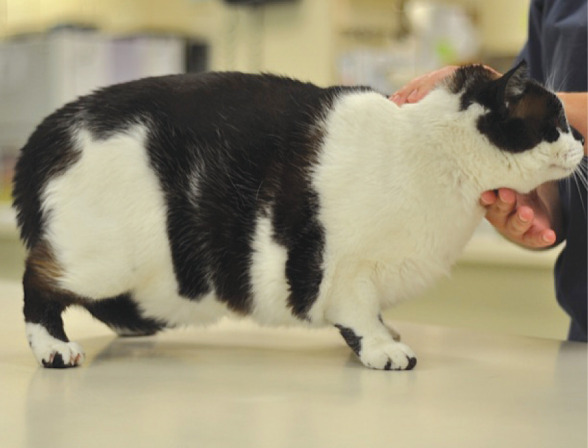
Obese cat weighing 8.6 kg (ideal weight 4.5 kg). Courtesy of the Association for Pet Obesity Prevention
Table 1.
Equivalent weight for adult cats and humans
| Cat’s weight (kg) | Percentage overweight | Equivalent weight for a 5’4” adult woman (kg) | Equivalent kg overweight for adult woman | Equivalent weight for a 5’9” adult man (kg) | Equivalent kg overweight for adult man |
|---|---|---|---|---|---|
| 4.5 | 0% | 65.8 | 0 | 76.7 | 0 |
| 4.9 | 10% | 72.6 | 6.8 | 84.4 | 7.7 |
| 5.9 | 30% | 85.7 | 20.0 | 99.8 | 23.1 |
| 6.8 | 50% | 98.9 | 33.1 | 115.2 | 38.6 |
| 9.0 | 100% | 131.5 | 65.8 | 153.3 | 76.7 |
| 9.5 | 110% | 138.3 | 72.6 | 161.0 | 84.4 |
| 10.4 | 130% | 151.5 | 85.7 | 176.4 | 99.8 |
| 11.3 | 150% | 164.7 | 98.9 | 191.9 | 115.2 |
Adapted from the Association for Pet Obesity Prevention
A number of different body condition scoring systems have been proposed for companion animals including a system with a five-point scale that was referred to earlier. Figure 2 shows a nine-point system that has been validated for use with cats, both in terms of reproducibility between trained observers and body composition using dual energy x-ray absorptiometry (DEXA). 16 The system uses a combination of evaluation of body silhouette and palpation for assessment of adiposity. The owner should be instructed to palpate for the abdominal fat pad in the cat’s inguinal region in addition to palpating for body fat over the cranial rib cage. Some cats may have a large abdominal fat pad and yet only a minimal fat covering over their ribs. Any palpable fat pad denotes an excess of body fat, regardless of the amount of fat covering over the rib cage. 16 For cats, a BCS of 5/9 is considered optimal. Based on DEXA, this score reflects 25–30% body fat; each increment in BCS above or below approximates to an increase or decrease of 10–15% in body weight. 16 (It is important to realize that this guide fails at 9/9, as patients that are morbidly obese can far exceed this scale.)
Figure 2.
Nine-point body condition scoring system validated for use in cats. Courtesy of Dorothy Laflamme/Nestlé Purina
At each clinic visit every patient should have its BCS assessed and recorded, along with an accurately obtained body weight. Weight change can easily be calculated and thus can help to detect trends before they become dramatic.
Accurate accounting of caloric intake
A complete diet history is essential for developing an effective weight loss program for your patients. Not only will it give an accurate account of all foods fed to a pet on a typical day, it will be an opportunity to evaluate all the ways that food is involved in interactions between the pet and the other members of its household, including other pets. The discussion of the patient’s diet is also a good time for the caregiver(s) to be given the opportunity to offer their viewpoints regarding the proposition of modifying their feeding practices. Particularly in cases where a weight reduction program may be indicated, it is absolutely necessary to assess the readiness of the caregiver to embark on such a project. If the caregiver does not recognize that a problem exists and does not see the necessity to address it, you will first need to try to bring their point of view into alignment with yours. If they are unwilling to address the problem at the present time, perhaps they will be more open to necessary changes at a future time.
The household
Begin by asking about who lives with the patient. How many adults and children are in the household? Are any of them at home all day with the cat? Inquire about whether there are other pets in the home and whether they are, or can be, fed separately from the cat. Can the cat access other pets’ food? Find out if it is confined indoors or not; if it does go out of doors, is it supervised when outside? Ask if the cat has the opportunity to steal food, get into garbage, scavenge or hunt (see diet history box, page 331).
The principal diet, feeding routines and eating behaviors
Obtain the precise names (including variety, if appropriate) and brands of any commercial cat foods that the patient is receiving and the specific amounts fed. Often the caregiver will not be able to provide this information accurately by recall alone, and will need to check labels and measure feeding portions. Specify that, if at all possible, dry pet foods be measured with a gram scale. A recent investigation found measuring cups to be a very imprecise means of portioning dry dog foods and it is highly likely that the same would be true for dry cat foods. 25 If using a scale to measure the food is not an option, ensure that the client is using a standard 250 ml/8 oz measuring cup. Often people don’t recognize that the ‘cup’ or scoop they are using is in excess of this. If the patient is eating a canned diet ask what size can. Sometimes a specific variety of cat food is sold in different sized cans (eg, 85 and 170 g/3 and 6 oz) so be certain to inquire about what size is used by the client. Don’t forget to ask whether the food the cat is currently eating is its usual diet and, if not, inquire when the diet change was implemented.
If the patient is eating a commercial cat food find out whether the diet is being supplemented with any human foods. If this is the case, or if the patient is being fed a home-prepared diet, it is important to get accurate details, including measured amounts, of all foods routinely given. Be certain to inquire whether the patient is receiving any dietary supplements. It is useful to have the cat owner bring in the supplements or at least the label information so you can see exactly what nutrients are being supplemented and in what quantities.
Ask whether the patient is fed at certain times during the day or whether food is given free choice. If the patient is fed with other cats or dogs, are the meals supervised? Does one person assume responsibility for feeding the patient or can it vary day to day? This is important to know when you are instituting a weight loss program because you may not be speaking with the person who will be implementing the new plan.
Inquire about the patient’s normal feeding behavior. Is this cat a picky eater? Does it eat the food as soon as it is offered or is it content to graze throughout the day? Does the cat usually eat all the food that is offered? Does it beg for food in between meal times?
Formulation of the weight loss plan
For a weight loss plan to be successful, the veterinarian needs to consider four key elements: what is fed, exercise, environmental enrichment and recheck visits. The first two determine the necessary negative energy balance; the second two support the psychologic needs and behavioral aspects of cat and owner, to improve ongoing compliance.
Counsel the client to produce a 1–2 week feeding journal into which everyone in the household who gives the cat anything ingestible enters information. The amount and exact type (brand) of food should be recorded. The client can be asked to generate this diet diary before the appointment and bring it along. While it may not be completely accurate, it provides a starting point for determining the caloric intake that the cat has been receiving and gaining weight on. This should be compared with the caloric allowance being recommended. If the diary is erroneous, it will become readily apparent as the cat fails to lose weight when fed the calculated, recommended quantities, and adjustments can be made.
As a rule of thumb, in order to lose weight a cat needs 60–70% of the calories required to maintain its ideal weight. In other words, the veterinarian needs to:
Determine/approximate the cat’s ideal weight (see right);
Calculate the calories needed for its ideal weight (wt [kg] x 40–50 kcal/kg/day);
Multiply this number by 60–70%.
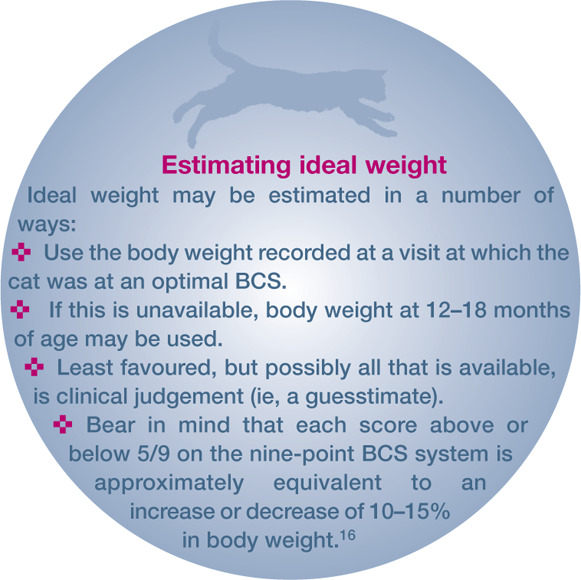
Some pet food companies provide software to help with the calculation that are specific to their weight loss diets.
The client should be informed of the cat’s current weight, as well as the goal weight. In some cases, the goal weight may be higher than the ‘ideal’ weight; the goal is a healthy weight. For example, in extremely obese pets (BCS 9/9), even though the weight loss plan will be based on the patient’s ideal weight, the client needs to appreciate that a loss of 20–30% body weight (which may represent a BCS of 6/9 or 7/9) will still provide health benefits. While this may not be sufficient weight loss to achieve the ideal weight, interim targets for the client to aim for provide motivation, and the cat’s quality of life will be dramatically better even if still overweight.
Discuss with the client the length of time this may take. A safe rate of weight loss is 0.5–2.0% body weight a week. This will help them stay the course.
What to feed
In general, it is not enough simply to feed a cat less of its normal diet. Not only will the patient be unhappy and feel hungry, but all nutrient quantities will be decreased, not just the calories, because commercial diets are balanced according to energy content. Therefore, a cat on a weight loss plan should be fed a diet formulated for caloric restriction that is fortified with all essential nutrients, so that when it eats the appropriate amount of calories, it still meets its protein, vitamin and mineral needs. A possible exception to this might be a cat that is only moderately overweight, in which case restriction or elimination of treats along with a modest reduction in the normal diet may be sufficient to permit weight loss. If treats are being eliminated, another non-caloric ‘treat’ (eg, interaction through play, combing or catnip) can be substituted.
There are a number of dietary approaches to feline weight loss:
High protein protects (minimizes loss of) lean mass, stimulates protein turnover, and may enhance satiety.26,27
High moisture can reduce caloric density, which promotes short-term weight loss. It can take a few weeks to a few months for a cat to compensate for the lower caloric density (as fed) in canned foods versus dry foods by increasing their volume of food intake; however, not all cats respond in this way. 28
High fiber can reduce caloric density and induce satiety. Some cats will self-restrict calorie intake when fed a dry, high-fiber, low-calorie diet.
Low fat will reduce caloric density. High-fat diets are a risk factor for inducing obesity and are generally not considered optimum for a weight loss diet. That said, some cats will lose weight on a high-protein, high-fat, low-carbohydrate diet.
Ultimately, it is calories ingested versus expended that is critical for weight loss. Given the benefits of achieving lean body mass by feeding a high-protein diet, a goal of at least 45% protein, on an energy basis, is a healthy approach to take.
Exercise
Caloric restriction alone is, in most cases, inadequate. Incorporating other modalities that increase calorie use and metabolic rate will help to achieve the goal of losing weight. Exercising cats might well be considered an oxymoron, but any exercise will help (Figure 3). Some dedicated clients have even designed agility obstacle courses for their cats. The Association for Pet Obesity Prevention offers some practical suggestions for clients (see resources box, page 335).
Figure 3.
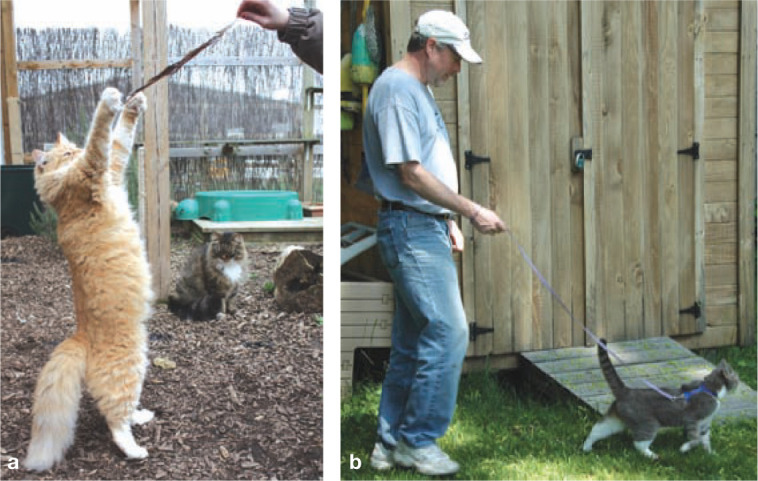
Exercise, in any shape or form, will help. Courtesy of (a) Sarah Ellis and (b) Deb Givin
It is in a cat’s nature to hunt by a process of slow, patient stalking and then, when opportune, leaping or running involving a short burst of effort and speed. This makes chasing a laser pointer or playing with a ‘cat dancer’ (a hand-held flexible wire with a toy on the end) a very suitable form of activity. (Note that when discontinuing play with a laser pointer, the spot should alight on a toy and be turned off when the cat has pounced on it so that the hunt can be ‘successful’.) It is helpful for owners to coincide the times they choose to exercise their cat with when the cat is naturally inclined to be most active. This tends to be early in the morning or later at night (their ‘crazy’ times!). One can also capitalize on the energy burst that some cats show after using the litterbox.
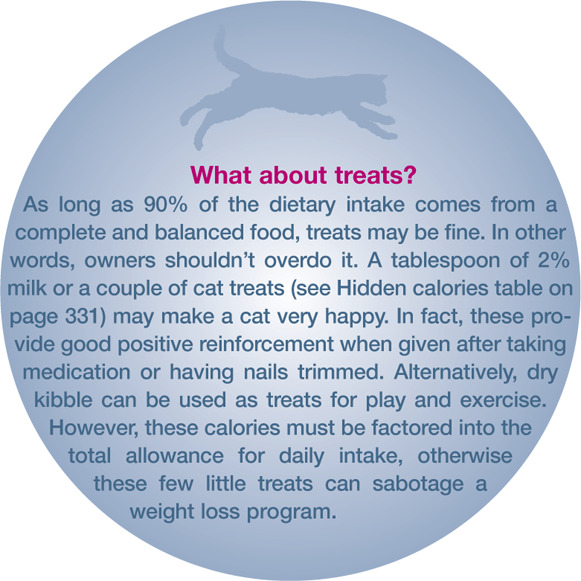
While the more prolonged and consistent energy required for running on, for example, a treadmill or exercise wheel may seem unreasonable to expect from a cat, some do seem perfectly happy to run on these exercise devices for several minutes at a time. Others readily take to leash walks. A search on YouTube will reveal numerous entertaining, but also informative, videos of cats exercising. It can be useful to show these to the clinic team and to clients as ideas to consider with their cat.
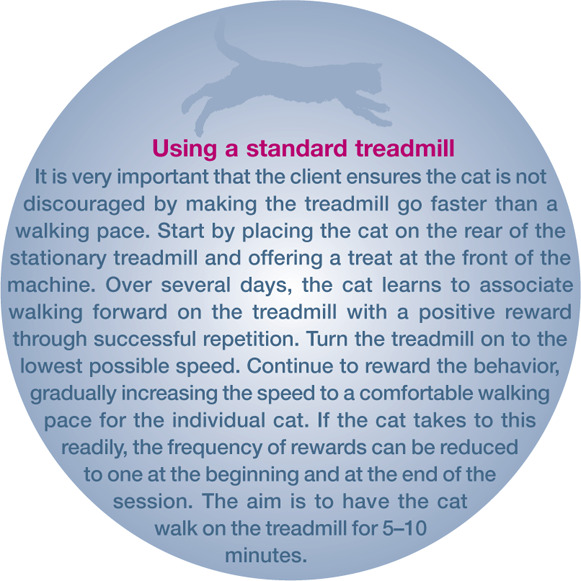
Clients should be encouraged to move the food bowl every few days so that the cat has to look for it on different levels and in different rooms of the house. Placing tiny portions of the calculated daily ration onto small plates or in muffin liners allows for a ‘treasure hunt’ throughout the day. In addition to a modest challenge and a bit of exercise, eating smaller amounts throughout the day increases the energy utilized to digest and absorb the food (the so-called thermic effect of food). It is important in a multi-cat household to ensure there is enough distance between bowls, to reduce any threat of proximity and competition. Other considerations for the multi-cat household, in which there may be conflicting nutritional needs, are discussed on page 335.
Environmental enrichment
We must also consider why the cat is eating more. Is it bored and sleeping most of the day? Is it not receiving enjoyable stimuli from other, more healthy sources and, therefore, eating? What other aspects of normal behaviour are not available for the cat to participate in? How is the cat meeting its emotional needs (‘hedonic budget’)? Chronic stress (which may be present in the indoor-confined cat) results in neuroendocrine changes that predispose to obesity. 29
Environmental enrichment has been extensively studied as it pertains to animal welfare.30–37 It has also been looked at briefly in the context of how it affects weight loss. 38 In a study of 19 two-cat indoor households, where one cat was overweight and the other of normal weight, nine households were randomly selected to be the control group. Their weight loss program consisted of counseling and directions to feed the two cats separately in two or more meals per day, closely monitoring the obese cat’s food intake. The goal weight was 90% of the cat’s initial weight, which allowed cats to lose 1–1.5% of their initial weight per week. The 10 treatment households received the same counseling and feeding recommendations but, in addition, underwent environmental enrichment. The enrichments consisted of additional food dishes, water bowls and litter boxes, as well as climbing trees, window perches, scratching posts, grooming supplies and toys. All cats (38) were weighed weekly and all wore activity monitors. Cats in the environmentally enriched group had increased activity counts and their caregivers were more positive about the weight loss program. While only a trend towards improved weight loss was noted, environmental enrichment (Figure 4) may be important not only in terms of a cat’s mental wellbeing, but also in improving commitment by the client. 38
Figure 4.
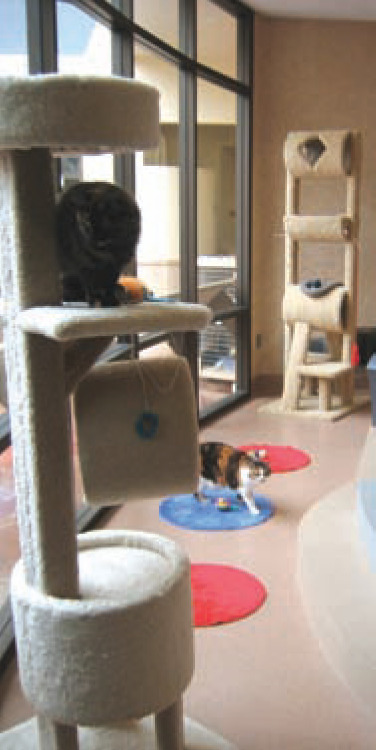
Environmental enrichment contributes to weight loss programs by promoting increased activity and, it appears, improving client commitment. Courtesy of Kate Hurley
Figure 5.
A selection of commercially available and home-made feeding devices. For weight control, the food must be measured as part of the daily ration. Courtesy of (a) Deb Givin, (b) Sarah Ellis and (c) Vicky Halls
Recheck visits
Weight loss requires commitment on the part of the client. It also requires commitment on the part of the clinic team because the client needs support and a motivator outside of themselves in order to persevere with the program. Success in losing weight often requires behavior changes in the client and the people who interact with the cat (see ‘What drives the client?’). Thus, recheck visits (initially every couple of weeks) are an essential part of a successful program. Create a bar graph to maintain in the clinic computer and cat’s medical record. Send an updated graph home with the client at every visit as a good reminder of their success. Positive reinforcement is a powerful motivator.
What drives the client?
A fascinating study by Kienzle and Bergler found that the emotional rewards/reinforcement that a client gets from interacting with their cat (the ‘positive strokes’), and the behaviors of clients towards their cats, differ with the cat’s weight. 17 These investigators found that more people living with overweight cats (versus cats of normal weight) had adopted their cat for emotional support and concluded that these individuals tended to humanize their cat companions. They underestimated their overweight cat’s BCS and enjoyed watching their cat eating. People with cats of normal weight played more with their cats. Surprisingly, the number of meals, snacks and types of food did not differ between the households; however, overweight cats received more treats, while normal-weight cats received a greater proportion of canned food.
So, in a cat’s weight, there is an element of meeting the hedonic budget for the person living with the cat. Hence, it is essential that we address the behavior of the people living with and feeding the cat! The value of encouraging alternative ‘strokes’ – things that make the person feel good about their interactions with the cat, such as play and a sense of pride in achieving weight loss goals – is not to be underestimated. Positive feedback, both from the veterinary team (the outside environment) as well as self-generated by the client, is vital to the success of a weight loss program.
The behavior modification required to make a weight loss program successful needs all key family members to play a role. Are there other forms of interaction that the client can have with the cat besides feeding? Treats are the downfall of many a weight control program; when used, their calories must be taken into consideration and deducted from the food calories fed. In order to decrease the risk of too many calories being fed, it is simpler if one person handles all of the feeding and others bond through other means (catnip, combing, playing). As described earlier, feeding multiple small meals as a treasure hunt is beneficial. Developing a routine involving several periods of play a day will add interest and exercise to the cat’s life. The cost of the program might just then include a bag of catnip and a cat dancer!
Acknowledgments
With grateful thanks to those who have supplied images for this article: Tony Buffington (title picture of cat on scales), Sarah Ellis, Deb Givin, Vicky Halls and Kate Hurley.
Key Points
The first step towards a healthy weight for an overweight or obese cat is recognizing excess body condition. Thereafter, success in achieving weight loss requires:
A cooperative approach between the cat’s family and the clinic team.
Understanding what quantity and type of food and treats are to be fed.
Encouraging some form of exercise.
Enriching the home environment and providing supportive follow-up.
Funding
The authors received no specific grant from any funding agency in the public, commercial or not-for-profit sectors for the preparation of this review article.
Conflict of interest
Kathryn Michel is a member of the Purina Scientific Advisory Council.
References
- 1. Lund EM, Armstrong PJ, Kirk CK, Klausner JS. Prevalence and risk factors for obesity in adult cats from private US veterinary practices. Intern J Appl Res Vet Med 2005; 3: 88–96. [Google Scholar]
- 2. Colliard L, Paragon B, Lemuet B, Bénet J, Blanchard G. Prevalence and risk factors of obesity in an urban population of healthy cats. J Feline Med Surg 2009; 11: 135–140. [DOI] [PMC free article] [PubMed] [Google Scholar]
- 3. Armstrong PJ, Lund EM. Changes in body composition and energy balance with aging. Vet Clin Nutr 1996; 3: 83–86. [Google Scholar]
- 4. Toll PW, Yamka RM, Schoenherr WD, Hand MS. Obesity. In: Hand MS, Thatcher CD, Remillard RL, Roudebush P, Novotny BJ. (eds). Small animal nutrition V. Topeka: Kansas, 2010, pp 501–542. [Google Scholar]
- 5. Willeberg P. Epidemiology of naturally occurring feline urologic syndrome. Vet Clin North Am Small Anim Pract 1984; 14: 455–469. [DOI] [PubMed] [Google Scholar]
- 6. Burrows CF, Chiapella AM, Jesyk P. Idiopathic feline hepatic lipidosis: the syndrome and speculations on its pathogenesis. Florida Vet J 1981; Winter: pp 18–20. [Google Scholar]
- 7. Scarlett JM, Donoghue S. Associations between body condition and disease in cats. J Am Vet Med Assoc 1998; 212: 1725–1731. [PubMed] [Google Scholar]
- 8. German AJ, Ryan VH, German AC, Wood IS, Trayhurn P. Obesity, its associated disorders and the role of inflammatory adipokines in companion animals. Vet J 2010; 185: 4–9. [DOI] [PubMed] [Google Scholar]
- 9. Nelson RW, Himsel CA, Feldman EC, Bottoms GD. Glucose tolerance and insulin response in normal-weight and obese cats. Am J Vet Res 1990; 51: 1357–1362. [PubMed] [Google Scholar]
- 10. Hoenig M. Comparative aspects of diabetes mellitus in dogs and cats. Mol Cell Endocrinol 2002; 197: 221–229. [DOI] [PubMed] [Google Scholar]
- 11. Hoenig M, Thomaseth K, Waldron M, Ferguson DC. Insulin sensitivity, fat distribution, and adipocytokine response to different diets in lean and obese cats before and after weight loss. Am J Physiol Regul Integr Comp Physiol 2007; 292: R227–234. [DOI] [PubMed] [Google Scholar]
- 12. Hoenig M, McGoldrick JB, deBeer M, Demacker PN, Ferguson DC. Activity and tissue-specific expression of lipases and tumor-necrosis factor [alpha] in lean and obese cats. Domest Anim Endocrinol 2006; 30: 333–344. [DOI] [PubMed] [Google Scholar]
- 13. Ishioka K, Omachi A, Sasaki N, Kimura K, Saito M. Feline adiponectin: molecular structures and plasma concentrations in obese cats. J Vet Med Sci 2009; 71: 189–194. [DOI] [PubMed] [Google Scholar]
- 14. Kil DY, Swanson KS. Endocrinology of obesity. Vet Clin North Am Small Anim Pract 2010; 40: 205–219. [DOI] [PubMed] [Google Scholar]
- 15. Allan FJ, Pfeiffer DU, Jones BR, Esslemont DHB, Wiseman MS. A cross-sectional study of risk factors for obesity in cats in New Zealand. Prev Vet Med 2000; 46: 183–196. [DOI] [PubMed] [Google Scholar]
- 16. Laflamme DP. Development and validation of a body condition score system for cats: a clinical tool. Feline Pract 1997; 25: 13–18. [Google Scholar]
- 17. Kienzle E, Bergler R. Human–animal relationship of owners of normal and overweight cats. J Nutr July 2006; 136 (Suppl): 1947S–1950S. [DOI] [PubMed] [Google Scholar]
- 18. Cornell KK, Brandt JC, Bonvicini KA. It may be a dog’s life but the relationship with her owner is also key to her health and well being: communication in veterinary medicine. Vet Clin North Am Small Anim Pract 2007; 37: 1–17. [DOI] [PubMed] [Google Scholar]
- 19. Scarlett JM, Donoghue S. Overweight cats: prevalence and risk factors. Int J Obes 1994; 18: S22–28. [PubMed] [Google Scholar]
- 20. Flynn MF, Hardie EM, Armstrong PJ. Effect of ovariohysterectomy on maintenance energy requirement in cats. J Am Vet Med Assoc 199; 209: 1572–1581. [PubMed] [Google Scholar]
- 21. Hoenig M, Ferguson DC. Effects of neutering on hormonal concentrations and energy requirements in male and female cats. Am J Vet Res 2002; 63: 634–639. [DOI] [PubMed] [Google Scholar]
- 22. Fettman MJ, Stanton CA, Banks LL, Hamar DW, Johnson DE, Hegstad RL, et al. Effects of neutering on body weight, metabolic rate and glucose tolerance of domestic cats. Res Vet Sci 1997; 62: 131–136. [DOI] [PubMed] [Google Scholar]
- 23. Kanchuk ML, Backus RC, Calvert CC, Morris JG, Rogers QR. Weight gain in gonadectomized normal and lipoprotein lipase-deficient male domestic cats results in increased food intake and not decreased energy expenditure. J Nutr 2003; 133: 1966–1974. [DOI] [PubMed] [Google Scholar]
- 24. Belsito KR, Vester BM, Keel T, Graves TK, Swanson KS. Impact of ovariohysterectomy and food intake on body composition, physical activity, and adipose gene expression in cats. J Anim Sci 2009; 87: 594–602. [DOI] [PubMed] [Google Scholar]
- 25. German AJ, Holden SL, Mason SL, Bryner C, Bouldoires C, Morris PJ, et al. Imprecision when using measuring cups to weigh out extruded dry kibbled food. J Anim Phys Anim Nutr 2011; 95: 368–373. [DOI] [PubMed] [Google Scholar]
- 26. Laflamme DP, Hannah SS. Increased dietary protein promotes fat loss and reduces loss of lean body mass during weight loss in cats. Intern J Appl Res Vet Med 2005; 3: 62–68. [Google Scholar]
- 27. Vasconcellos RS, Borges NC, Gonçalves KNV, Canola JC, de Paula FJA, Malheiros EB, et al. Protein intake during weight loss influences the energy required for weight loss and maintenance in cats. J Nutr 2009; 139: 855–860. [DOI] [PubMed] [Google Scholar]
- 28. Stoll JA, Laflamme DP. Effects of dry vs canned rations on food intake and bodyweight in cats. Vet Clin Nutr 1995; 2: 145. [Google Scholar]
- 29. Buffington CAT. External and internal influences on disease risk in cats. J Am Vet Med Assoc 2002; 220: 994–1002. [DOI] [PubMed] [Google Scholar]
- 30. Ellis SL. Environmental enrichment: practical strategies for improving feline welfare. J Feline Med Surg 2009; 11: 901–912. [DOI] [PMC free article] [PubMed] [Google Scholar]
- 31. Shepherdson DJ, Carlstead K, Mellen JD, Seidensticker J. The influence of food presentation on the behavior of small cats in confined environments. Zoo Biology 1993; 12: 203–216. [Google Scholar]
- 32. Fox C, Merali Z, Harrison C. Therapeutic and protective effect of environmental enrichment against psychogenic and neurogenic stress. Behav Brain Res 2006; 175: 11–18. [DOI] [PubMed] [Google Scholar]
- 33. Westropp JL, Kass PH, Buffington CAT. Evaluation of the effects of stress in cats with idiopathic cystitis. Am J Vet Res 2006; 67: 731–736. [DOI] [PubMed] [Google Scholar]
- 34. Buffington CAT, Westropp JL, Chew DJ, Bolus RR. Risk factors associated with clinical signs of lower urinary tract disease in indoor-housed cats. J Am Vet Med Assoc 2006; 228: 722–725. [DOI] [PubMed] [Google Scholar]
- 35. Zoran DL, Buffington CAT. Effects of nutrition choices and lifestyle changes on the well-being of cats, a carnivore that has moved indoors. J Am Vet Med Assoc 2011; 239: 596–606. [DOI] [PubMed] [Google Scholar]
- 36. Buffington CA. External and internal influences on disease risk in cats. J Am Vet Med Assoc 2002; 220: 994–1002. [DOI] [PubMed] [Google Scholar]
- 37. Mohammed AH, Zhu SW, Darmopil S, Hjerling-Leffler J, Ernfors P, Winblad B, et al. Environmental enrichment and the brain. Prog Brain Res 2002; 138: 109–133. [DOI] [PubMed] [Google Scholar]
- 38. Trippany JR, Funk J, Buffington CAT. Effects of environmental enrichments on weight loss in cats [abstract]. J Vet Intern Med 2003; 17: 430. [Google Scholar]



